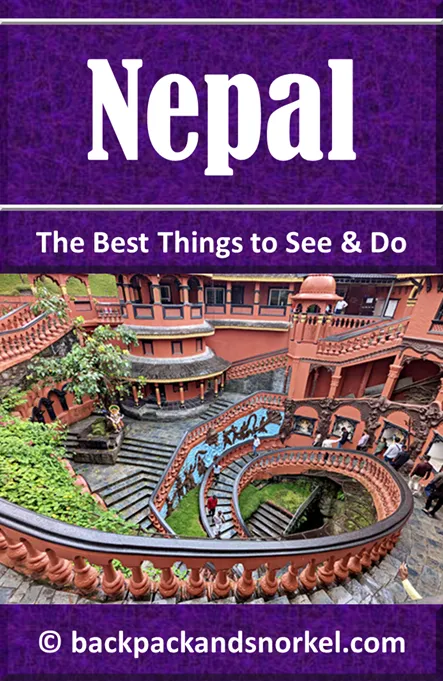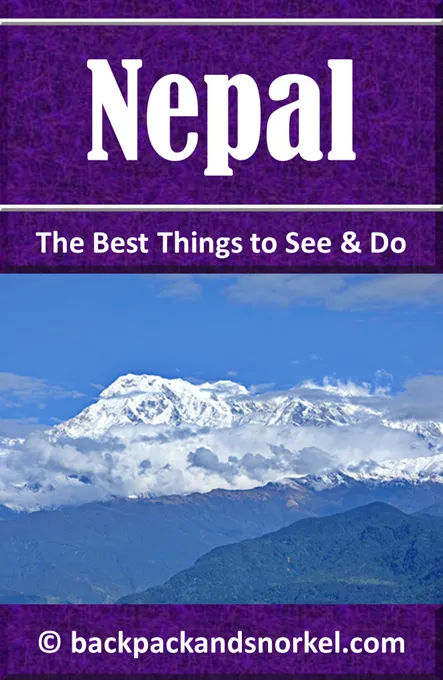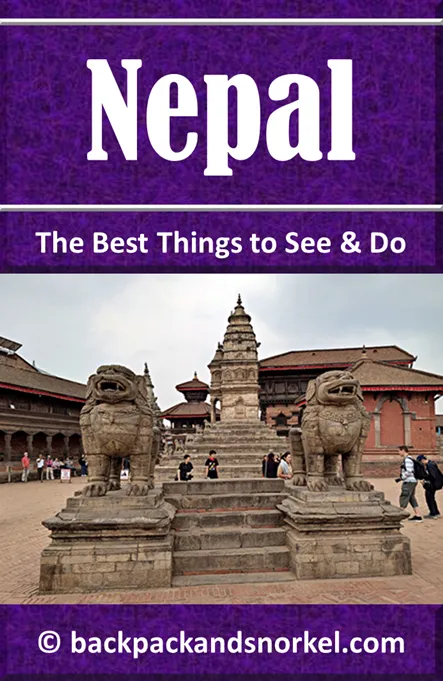Self-Guided Kathmandu Durbar Square Walking Tour: Explore History at Your Own Pace - Nepal Purple Travel Guide
No visit to Kathmandu is complete without experiencing the timeless grandeur of Kathmandu Durbar Square, one of the city’s most iconic and culturally rich landmarks. Also known as Hanuman Dhoka Durbar Square, this UNESCO World Heritage Site offers a fascinating glimpse into Nepal’s royal past, and intricate Newar architecture.
Here at Backpack and Snorkel Travel Guides, we typically promote self-guided walking tours.
But we realize that not everybody likes to walk by themselves in a foreign city. So, just in case that you rather go with ab guide: NO PROBLEM! Please see the Viator tours below.
free GuruWalk tours
paid Viator tours
Origin of the Name Kathmandu Durbar Square
The term ‘Durbar Square’ literally means ‘Palace Square’, and in Kathmandu, it refers to the plaza in front of the old royal palace of the Malla kings, who ruled the Kathmandu Valley from the 12th to the 18th century. The name ‘Hanuman Dhoka’ comes from the statue of Hanuman, the monkey god and devoted servant of Lord Ram, which stands at the palace entrance. The word Dhoka means ‘gate’.
Kathmandu Durbar Square: A Living Museum of History and Culture
Kathmandu Durbar Square is a stunning showcase of traditional Nepali architecture, where intricately carved wooden windows, tiered pagoda-style temples, and open courtyards create a setting that feels both ancient and alive.
Modern-Day Use and Cultural Significance of Kathmandu Durbar Square
While no longer the seat of power, Kathmandu Durbar Square remains a spiritual, ceremonial, and social hub. It hosts several major festivals throughout the year, including Indra Jatra, when the Kumari is paraded through the streets in a chariot procession.
Locals gather here to socialize, rest, or offer prayers, while artisans, street vendors, and performers create a dynamic atmosphere. Despite significant damage from the 2015 earthquake, many of the temples have been restored, or are under reconstruction, preserving their legacy for future generations.
Self-Guided Walking Tour of Kathmandu Durbar Square
If you have followed our Thamel walking tour, then you will enter Kathmandu Durbar Square from the west.
Please be advised, that foreigners must pay an admission of Rs1000 per person at the payment booths – Nepali citizens can enter for free. There are no barriers that restrict you from entering, but if you don’t pay, then it will only be a matter of time that a guard will find you, and ask you to go to the payment booth and pay.
Kathmandu Durbar Square is open 24/7, and admission is typically collected from 9am – 6pm.
Some of the buildings are open to visitors. Their opening times vary, but they are typically open from 9am – 6pm.
The following map shows the points of interest in Kathmandu Durbar Square::
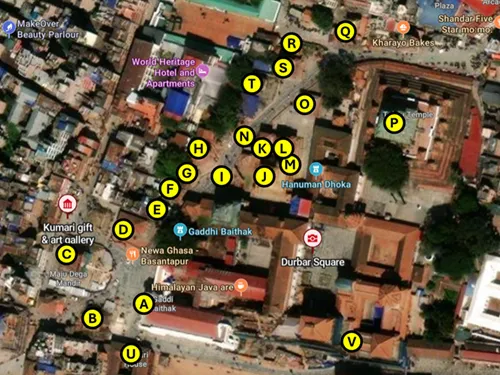
- Gaddi Baihak
- Trailokya Mohan Narayan Temple
- Maju Dega Temple
- Madyo Parvati Temple
- Tago Gan Bell
- Stone Vishnu Temple
- Saraswoti Temple
- Cyasilim Dega
- King Pratap Malla Column
- Jagannath Temple
- Indrapur Temple
- Maha Vishnu Temple
- Shiva Temple
- Shree Kaal Bhairav Temple
- Kageswor Mahadev Temple
- Taleju Bhawani Temple
- Makhan Mahadev Temple
- Nil Barahi Temple
- Kotilingeshwar Mahadev Temple
- Shree Bhuvaneshwor Mahadev Temple
- Kumari Ghar
- Hanuman Dhoka Palace
Gaddi Baihak at Kathmandu Durbar Square
(map, reviews)
This is Premium Content! To access it, please download our
Backpack and Snorkel Purple Travel GuideStart your self-guided walking tour of Kathmandu Durbar Square at the white building, Gaddi Baihak, that sticks out among the other earth-toned buildings.
Detailed information can be found at our Gaddi Baihak Page
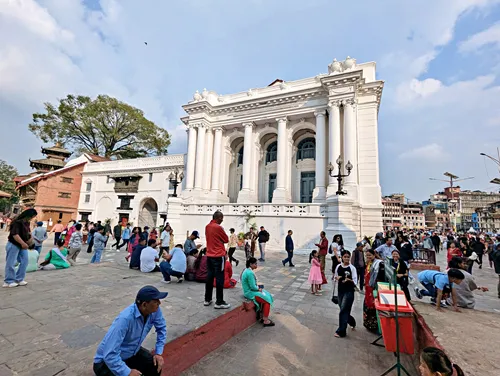

Trailokya Mohan Narayan Temple at Kathmandu Durbar Square
(map, reviews)
This is Premium Content! To access it, please download our
Backpack and Snorkel Purple Travel GuideTurn around and you will see two temples that were built on platforms with tall steps leading to them. The temple on the left, which has an approx. 2-3 ft (70-78 cm) tall platform in front of it is Trailokya Mohan Narayan Temple.
The Trailokya Mohan Narayan Temple in Kathmandu Durbar Square is a 17th-century pagoda-style temple dedicated to Lord Vishnu. Known for its detailed Newar architecture and spiritual significance, this temple stands as a symbol of divine preservation and cultural heritage in the heart of Nepal’s capital.
Detailed information can be found at our Trailokya Mohan Narayan Temple Page
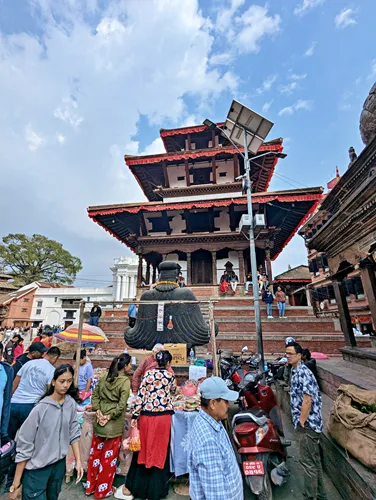
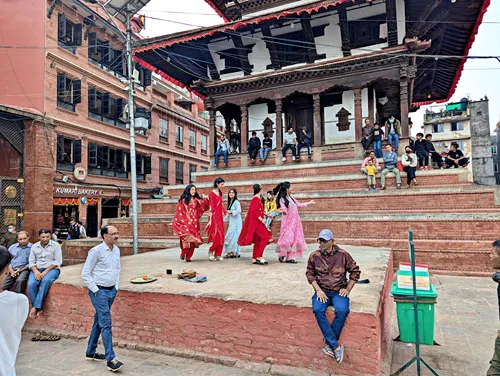
Maju Dega Temple at Kathmandu Durbar Square
(map, reviews)
This is Premium Content! To access it, please download our
Backpack and Snorkel Purple Travel GuideThe second of the 2 temples with the steps leading to them, to the right (north) of Trailokya Mohan Narayan Temple is Maju Dega Temple.
Maju Dega Temple in Kathmandu Durbar Square is a historically significant 17th-century Shiva temple, once known for its towering architecture and central role in Kathmandu’s social and spiritual life.
Detailed information can be found at our Maju Dega Temple Page
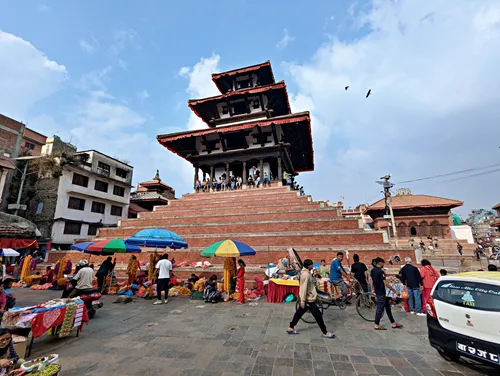
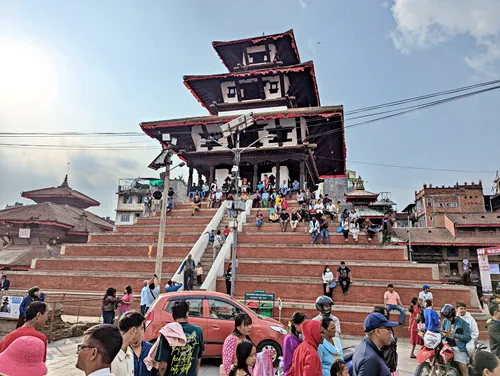
Madyo Parvati Temple at Kathmandu Durbar Square
(map, reviews)
This is Premium Content! To access it, please download our
Backpack and Snorkel Purple Travel GuideDirectly north of Maju Dega Temple is another temple: Madyo Parvati Temple.
The Madyo Parvati Temple in Kathmandu Durbar Square is a sacred Hindu shrine dedicated to Goddess Parvati, known for its cultural significance, traditional Newar architecture, and active role in local religious life.
Detailed information can be found at our Madyo Parvati Temple Page
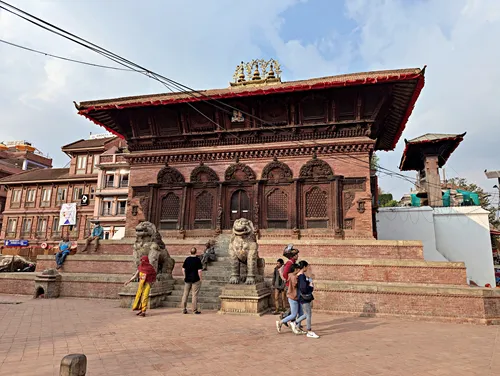
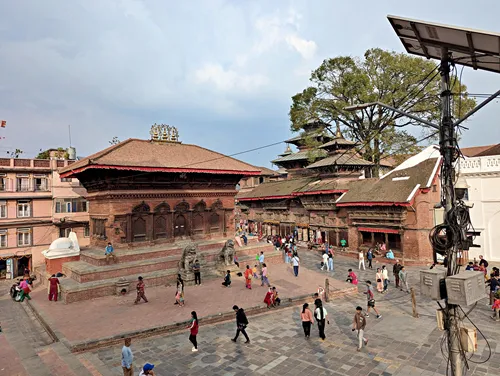
Tago Gan Bell at Kathmandu Durbar Square
(map, reviews)
This is Premium Content! To access it, please download our
Backpack and Snorkel Purple Travel GuideWalk farther north to Tago Gan Bell. As of 2025, the bell structure is still fenced off while it is being repaired after the 2015 earthquake destroyed it in part. But you are able to see the bell above the fence.
Tago Gan Bell in Kathmandu Durbar Square is a historic bronze bell that once served as a vital tool for royal communication and public rituals.
Detailed information can be found at our Tago Gan Bell Page

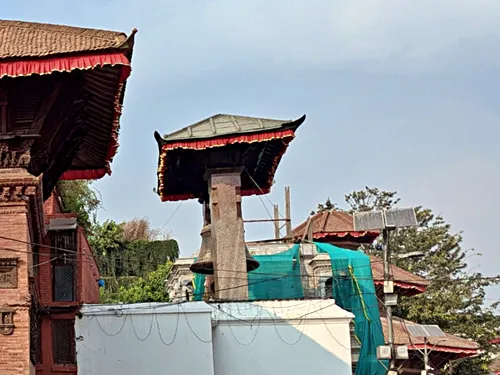
Stone Vishnu Temple at Kathmandu Durbar Square
(map, reviews)
This is Premium Content! To access it, please download our
Backpack and Snorkel Purple Travel GuideYour next destination is right next (north) to Tago Gan Bell. As of 2025, this temple is still fenced off while it is being repaired and partially reconstructed after the 2015 earthquake destroyed it.
Stone Vishnu Temple in Kathmandu Durbar Square is a modest shrine dedicated to Lord Vishnu, known for its stone construction and historical significance.
Detailed information can be found at our Stone Vishnu Temple Page
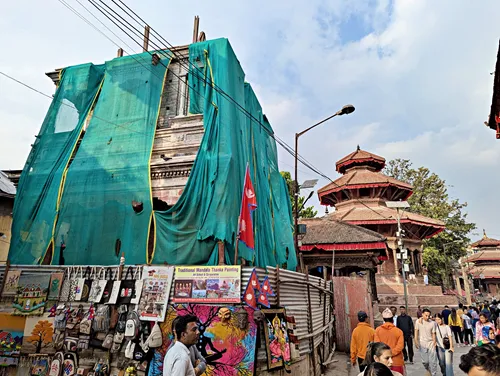
Saraswoti Temple at Kathmandu Durbar Square
(map, reviews)
This is Premium Content! To access it, please download our
Backpack and Snorkel Purple Travel GuideDirectly behind (north) Stone Vishnu Temple lies Saraswoti Temple.
Saraswoti Temple in Kathmandu Durbar Square is a revered shrine dedicated to the Hindu goddess of wisdom and learning.
Detailed information can be found at our Saraswoti Temple Page

Cyasilim Dega at Kathmandu Durbar Square
(map, reviews)
This is Premium Content! To access it, please download our
Backpack and Snorkel Purple Travel GuideDirectly behind (north) and pass some fenced-off buildings that are currently being reconstructed after the 2015 earthquake destroyed them, and you arrive at Cyasilim Dega.
Cyasilim Dega in Kathmandu Durbar Square is a beautifully restored octagonal temple that reflects the rich Newar architectural heritage and spiritual traditions of the Malla era. With its elegant multi-tiered pagoda architecture and elevated platform, Cyasilim Dega is a historically significant temple in the heart of Kathmandu Durbar Square.
Detailed information can be found at our Cyasilim Dega Page
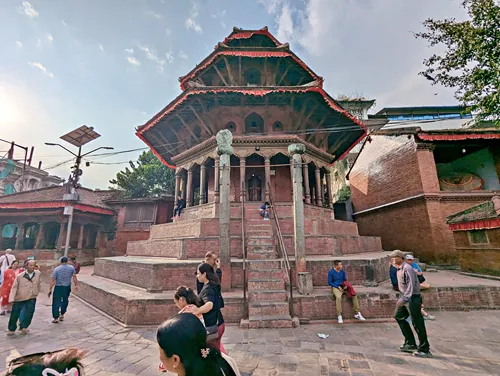

King Pratap Malla Column at Kathmandu Durbar Square
(map, reviews)
This is Premium Content! To access it, please download our
Backpack and Snorkel Purple Travel GuideTurn around and you will see the King Pratap Malla Column.
Rising proudly from the center of Kathmandu Durbar Square, the King Pratap Malla Column is one of the most iconic and symbolic monuments in the area.
King Pratap Malla was one of the most renowned monarchs of the Malla dynasty, who ruled Kantipur (Kathmandu) from 1641 to 1674.
Detailed information can be found at our King Pratap Malla Column Page


Jagannath Temple at Kathmandu Durbar Square
(map, reviews)
This is Premium Content! To access it, please download our
Backpack and Snorkel Purple Travel GuideBehind the King Pratap Malla Column, stands one large temple and, to the left side (north), three smaller temples. The roofs of all four temples are visited by hundreds of pigeons. The largest of the four temples, Jagannath Temple, is your next destination.
Jagannath Temple in Kathmandu Durbar Square is a 16th-century Hindu temple dedicated to Lord Jagannath. As one of the oldest and most artistically rich temples in the square, it is known for its unique wooden carvings and spiritual importance.
Detailed information can be found at our Jagannath Temple Page
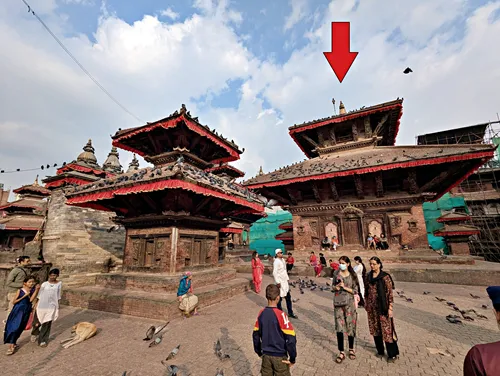
Indrapur Temple at Kathmandu Durbar Square
(map, reviews)
This is Premium Content! To access it, please download our
Backpack and Snorkel Purple Travel GuideTo the left (north) of Jagannath Temple sit three smaller temples. Start with the temple on the left (west), which is Indrapur Temple.
Indrapur Temple in Kathmandu Durbar Square is a small but culturally rich shrine dedicated to Lord Indra, the Vedic god of rain and the heavens. Known for its role in the annual Indra Jatra festival, the temple reflects the spiritual heritage and architectural style of the Newar people.
Detailed information can be found at our Indrapur Temple Page

Maha Vishnu Temple at Kathmandu Durbar Square
(map, reviews)
This is Premium Content! To access it, please download our
Backpack and Snorkel Purple Travel GuideLocated right behind (east) Indrapur Temple is Maha Vishnu Temple, or often just called Vishnu Temple.
Maha Vishnu Temple in Kathmandu Durbar Square is a small but spiritually rich shrine dedicated to Lord Vishnu, the Hindu god of preservation.
Detailed information can be found at our Maha Vishnu Temple Page

Shiva Temple at Kathmandu Durbar Square
(map, reviews)
This is Premium Content! To access it, please download our
Backpack and Snorkel Purple Travel GuideBehind (east) Maha Vishnu Temple sits another small temple called Shiva Temple.
The Shiva Temple in Kathmandu Durbar Square, located just east of the Maha Vishnu Temple, is a beautifully preserved three-tiered pagoda which is often thought to be dedicated to Lord Shiva, one of the principal deities in Hinduism, known as the destroyer and transformer within the Holy Trinity (Trimurti) alongside Brahma and Vishnu. Signage and historical references are minimal, and the dedication to Lord Shiva is assumed, as it sits alongside the temples dedicated to Vishnu and Indra, which would form a symbolic triad of divine power in Hindu cosmology.
Detailed information can be found at our Shiva Temple Page
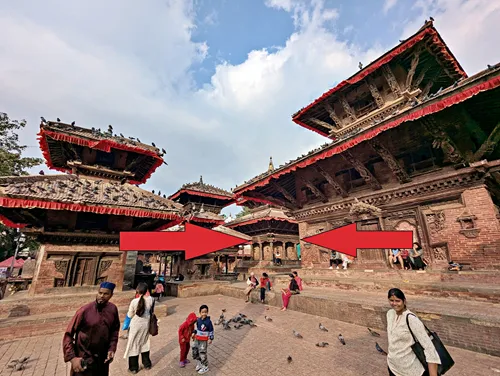

Shree Kaal Bhairav Temple at Kathmandu Durbar Square
(map, reviews)
This is Premium Content! To access it, please download our
Backpack and Snorkel Purple Travel GuideWalk back to Indrapur Temple. Your next destination is Shree Kaal Bhairav Temple, which is located directly behind (north) of it.
Shree Kaal Bhairav Temple in Kathmandu Durbar Square is a captivating open-air shrine featuring a colossal stone image of Kaal Bhairav, the fierce form of Lord Shiva. Known for its historical role in dispensing divine justice, the temple remains a powerful symbol of truth and protection.
Detailed information can be found at our Shree Kaal Bhairav Temple Page
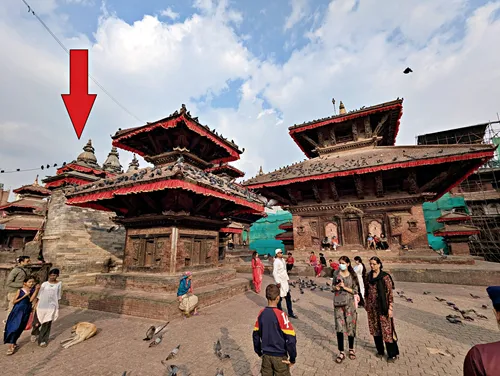
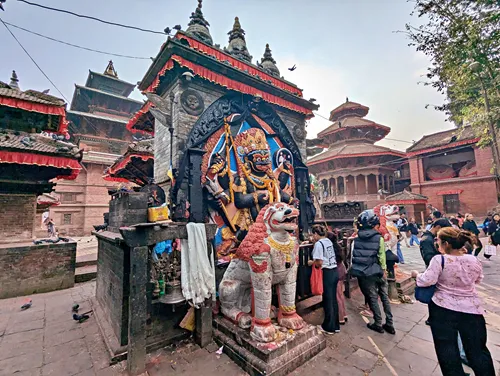
Kageswor Mahadev Temple (Bhuvaneswara) at Kathmandu Durbar Square
(map, reviews)
This is Premium Content! To access it, please download our
Backpack and Snorkel Purple Travel GuideKeep walking north from Shree Kaal Bhairav Temple towards the temple with the white roof. This is Kageswor Mahadev Temple, also called Bhuvaneswara.
The temple's dual name reflects its rich spiritual identity. ‘Kageswor’ is a combination of ‘Kaga’ (meaning crow) and ‘Ishwor’ (a term for God), hinting at a divine connection with birds, especially the crow, which is a symbol often associated with Lord Shiva and the ancestral world.
Detailed information can be found at our Kageswor Mahadev Temple (Bhuvaneswara) Page
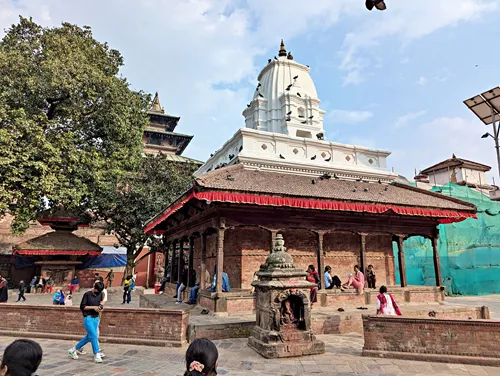
Taleju Bhawani Temple at Kathmandu Durbar Square
(map, reviews)
This is Premium Content! To access it, please download our
Backpack and Snorkel Purple Travel GuideBehind Kageswor Mahadev Temple, you will see two smaller shrines and a gate. Behind that gate lies Taleju Bhawani Temple.
Taleju Bhawani Temple is one of the most revered landmarks in Kathmandu Durbar Square. This sacred temple is dedicated to Taleju Bhawani, a powerful protective goddess and the royal deity of the Malla kings who ruled the Kathmandu Valley for centuries.
Detailed information can be found at our Taleju Bhawani Temple Page
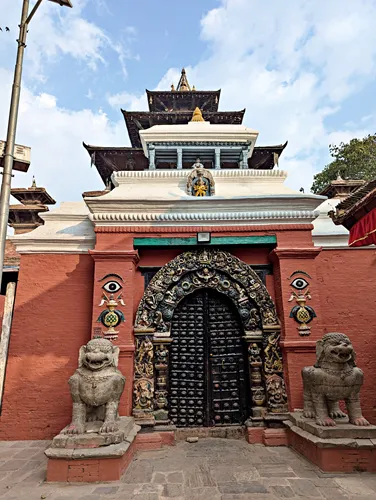

Makhan Mahadev Temple (Sano Pashupati) at Kathmandu Durbar Square
(map, reviews)
This is Premium Content! To access it, please download our
Backpack and Snorkel Purple Travel GuideNorth of the Kathmandu Durbar Square, behind the tall rectangular red brick arch, lies the Sano Pashupati Temple, also known as the Makhan Mahadev Temple.
The temple carries two names: Sano Pashupati, which means ‘Little Pashupati’. Pashupati (also spelled Pashupatinath) is one of the most revered forms of the Hindu god Shiva. The word Pashupati comes from Sanskrit ‘Pashu’ means ‘living beings’ or ‘animals, and ‘Pati’ means ‘lord’ or ‘protector’. So Pashupati translates to ‘Lord of all living beings’
Detailed information can be found at our Makhan Mahadev Temple (Sano Pashupati) Page
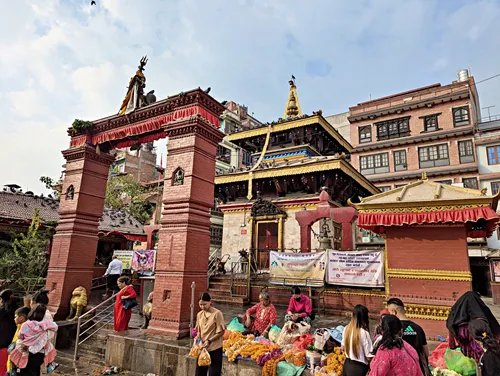
Nil Barahi Temple at Kathmandu Durbar Square
(map, reviews)
This is Premium Content! To access it, please download our
Backpack and Snorkel Purple Travel GuideTurn around, and walk back towards Kageswor Mahadev Temple with the white roof. On your right (western side) you will see two temples. The first, which is the smaller one, is Nil Barahi Temple.
The name Nil Barahi is derived from the goddess Barahi, a form of the powerful Hindu goddess Durga, worshipped as the protector of the home and the embodiment of strength. The word ‘Nil’ means ‘blue’ in Nepali, which refers to the distinctive, blue-faced depiction of the goddess. Nil Barahi is one of the forms of Barahi that is particularly revered in the Newar community of Kathmandu.
Detailed information can be found at our Nil Barahi Temple Page
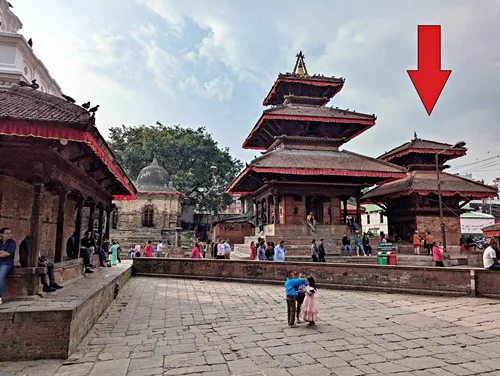
Kotilingeshwar Mahadev Temple at Kathmandu Durbar Square
(map, reviews)
This is Premium Content! To access it, please download our
Backpack and Snorkel Purple Travel GuideDirectly behind (south) Nil Barahi Temple is a similar looking, but slightly larger temple. This is Kotilingeshwar Mahadev Temple.
The name Kotilingeshwar is derived from two Sanskrit words: ‘Koti’ meaning ‘a million’ and ‘Lingeshwar’, referring to Lord Shiva (also known as Lingeshwar, the deity represented by the Shiva Lingam (abstract or symbolic representation of Lord Shiva, often found in temples)). The name suggests the presence of a multitude of Shiva Lingams, a common feature in temples dedicated to Lord Shiva, where hundreds or even thousands of lingams are often enshrined in a single temple compound. It’s believed that the temple’s lingams represent the infinite nature of the divine and the limitless presence of Lord Shiva.
Detailed information can be found at our Kotilingeshwar Mahadev Temple Page
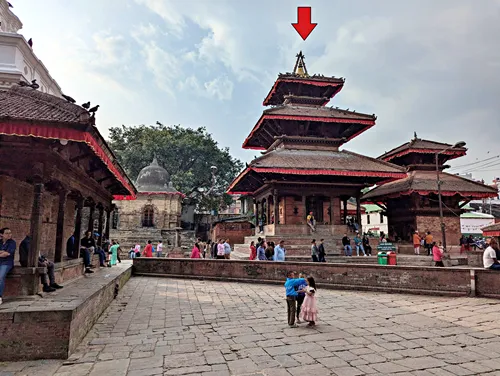

Shree Bhuvaneshwor Mahadev Temple at Kathmandu Durbar Square
(map, reviews)
This is Premium Content! To access it, please download our
Backpack and Snorkel Purple Travel GuideContinue farther south and you will see Shree Bhuvaneshwor Mahadev Temple, which looks very different from all the temples you have seen so far.
The name Bhuvaneshwor Mahadev combines two key elements from Hindu tradition. ‘Bhuvaneshwor’ translates to ‘Lord of the Universe’, a reference to Lord Shiva, who is considered the supreme deity in Hinduism. The name emphasizes the temple’s dedication to Lord Shiva in his form as the ruler of all realms. ‘Mahadev’ is another name for Shiva, highlighting his divine and cosmic authority.
Detailed information can be found at our Shree Bhuvaneshwor Mahadev Temple Page
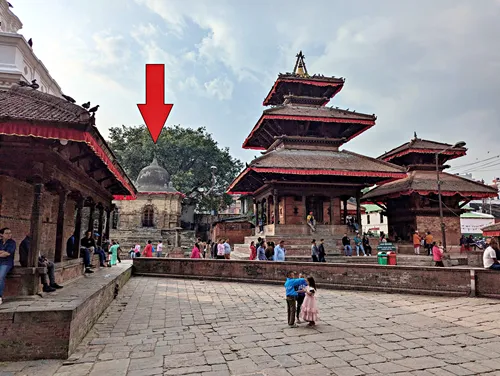
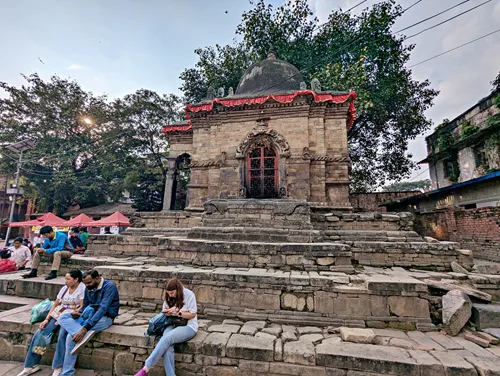
Kumari Ghar at Kathmandu Durbar Square
(map, reviews)
This is Premium Content! To access it, please download our
Backpack and Snorkel Purple Travel GuideNow walk back to the white Gaddi Baihak building where you started your tour of Kathmandu Durbar Square, and keep walking a few feet more until the road makes a sharp left and turns into a plaza. The building before you is Kumari Ghar.
Kumari Ghar is not just a building – it is the living heart of a centuries-old tradition that continues to define Kathmandu's spiritual identity.
The name ‘Kumari Ghar’ literally means ‘House of the Kumari’ in Nepali. ‘Kumari’ refers to a virgin girl, chosen from the Newar Shakya caste, who undergoes a rigorous selection process to become the living goddess. ‘Ghar’ simply means ‘house’. The building serves as both her home and temple, where she lives in semi-seclusion and receives daily worship from priests and devotees.
Detailed information can be found at our Kumari Ghar Page
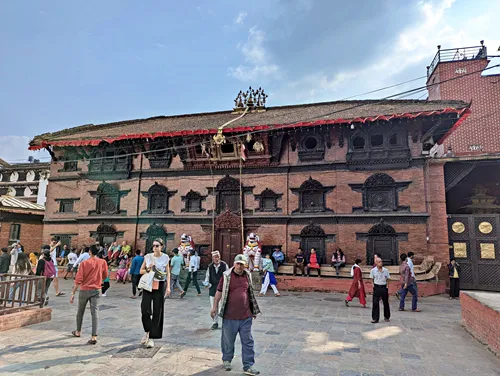
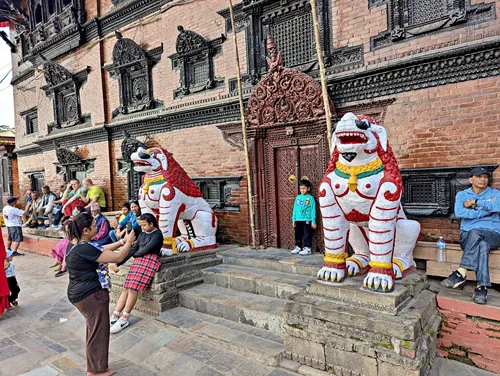
Hanuman Dhoka Palace at Kathmandu Durbar Square
(map, reviews)
This is Premium Content! To access it, please download our
Backpack and Snorkel Purple Travel GuideKeep walking to the left (east), until you see the orange-red brick Hanuman Dhoka Palace to your left, directly after the whitewashed walls of Gaddi Baihak.
Hanuman Dhoka Palace is one of the most important historical landmarks in Nepal. This sprawling palace complex served as the royal residence of the Malla kings and later the Shah dynasty rulers, making it a key center of political and ceremonial power for centuries.
Detailed information can be found at our Hanuman Dhoka Palace Page

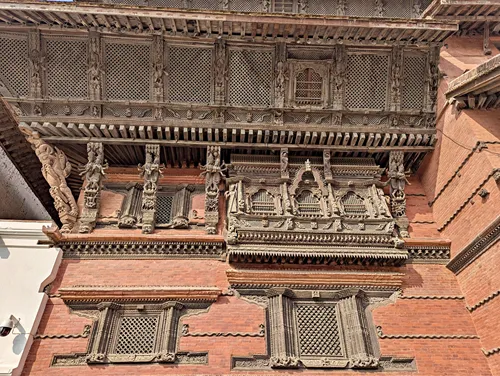
Nine Storey Palace at Hanuman Dhoka Palace
Rising above the historic heart of Kathmandu Durbar Square, the Nine Storey Palace, also known as Basantapur Tower, is one of the most iconic landmarks in the Kathmandu Valley. With its soaring structure and elegant Newar architecture, it once served as the royal watchtower and a symbol of monarchical power during Nepal’s Malla and Shah dynasties.
Detailed information can be found at our Hanuman Dhoka Palace Page

Hanuman Dhoka at Hanuman Dhoka Palace
Hanuman Dhoka is the main entrance to the Hanuman Dhoka Palace Complex, once the seat of power for the Malla kings and later the Shah dynasty.
Don’t let the of the gate size fool you, Hanuman Dhoka is more than an entryway – it is a symbol of power, protection, and tradition. It served as the ceremonial and functional gate to the Hanuman Dhoka Palace, a sprawling complex that was the official residence of the royal family until the late 19th century.
The gateway itself is richly decorated with traditional Newar woodwork and carvings, blending artistic beauty with spiritual symbolism. For centuries, kings, queens, and dignitaries passed through this gate during coronations, rituals, and festivals.
Detailed information can be found at our Hanuman Dhoka Palace Page
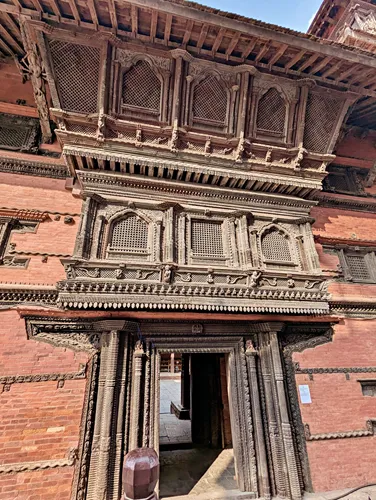
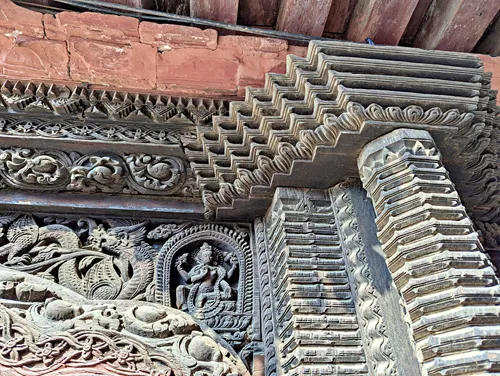
Nasal Chowk at Hanuman Dhoka Palace
Enter the palace complex through Hanuman Dhoka, and you will get into a courtyard called Nasal Chowk.
The name Nasal Chowk comes from the Sanskrit word ‘Nata’, meaning dance. Nata is associated with Natareshwor, a form of the Hindu god Shiva depicted in a dancing pose. A small shrine to Nasal God (dancing Shiva) sits in one corner of the courtyard, giving the space its name.
The word ‘chowk’ has its origins in Hindi and Sanskrit, and means courtyard.
Detailed information can be found at our Hanuman Dhoka Palace Page
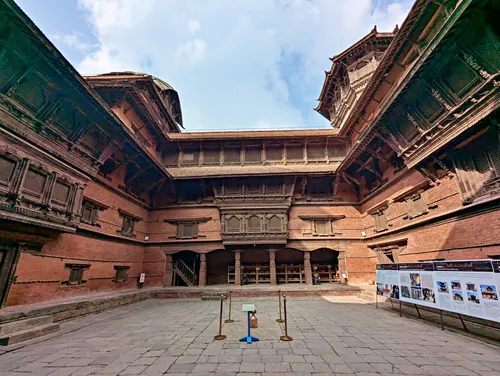
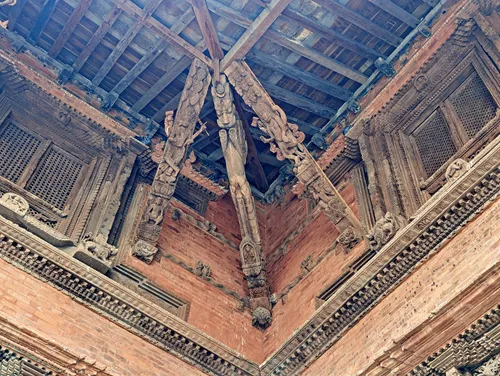
Naag Pokhari at Hanuman Dhoka Palace
The name Naag Pokhari comes from two Nepali words:
Naag: A mythical serpent deity in Hindu and Buddhist tradition, often associated with water and rain.
Pokhari: A pond or water tank.
Naags are considered protectors of water sources, and Naag Pokhari is believed to be a sacred home or offering site to these serpent spirits.
Detailed information can be found at our Hanuman Dhoka Palace Page
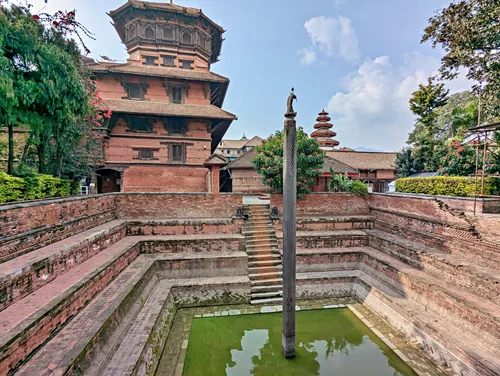

King Mahendra Jeep at Hanuman Dhoka Palace
Among the ancient temples and medieval courtyards of Kathmandu Durbar Square, a somewhat unexpected yet fascinating artifact stands out: King Mahendra’s Jeep. Currently housed near Naag Pokhari, this vintage vehicle is more than just a car; it is a symbol of Nepal’s mid-20th-century transition from monarchy to modernity, and it played a role in an assassination attempt.
Detailed information can be found at our Hanuman Dhoka Palace Page
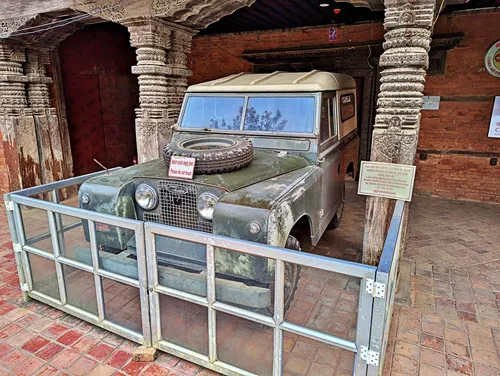
Plaza in Front of the Private Royal Quarters and Bilas Mandir at Hanuman Dhoka Palace
Constructed in the mid-17th century during the reign of the Malla kings, Mohan Chowk is a courtyard inside the Royal Palace, which is surrounded by buildings primarily used for royal residence, state ceremonies, and possibly for educational or cultural gatherings.
The buildings provide access to Bilas Mandir and other interior temple spaces.
While Mohan Chowk and the buildings surrounding it cannot be visited at the time of writing, you will likely have access to the plaza in front of it. The plaza has several interesting exhibits behind glass panes that you can see.
Of interest is also that the buildings surrounding the plaza are in traditional Newar style and in whitewashed Rana-era influenced style. The Rana prime ministers, who ruled Nepal after the Shahs, made significant modifications to the Hanuman Dhoka complex.
Among the whitewashed buildings is a round pagoda that sticks out: Bilas Mandir
Detailed information can be found at our Hanuman Dhoka Palace Page
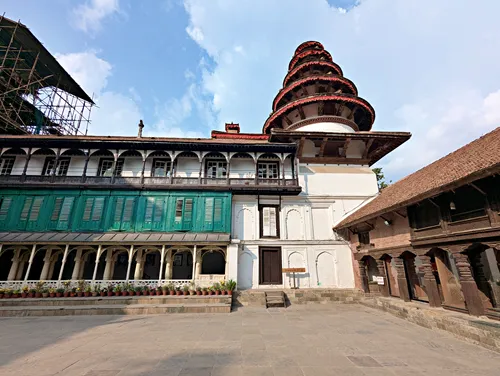

Back to your self-guided tour of Thamel
The next destination is: Akash Bhairab Temple
Where do you want to go now?
Author: Rudy at Backpack and Snorkel
Bio: Owner of Backpack and Snorkel Travel Guides. We create in-depth guides to help you plan unforgettable vacations around the world.
Other popular Purple Travel Guides you may be interested in:
Like this Backpack and Snorkel Purple Travel Guide? Pin these for later:

